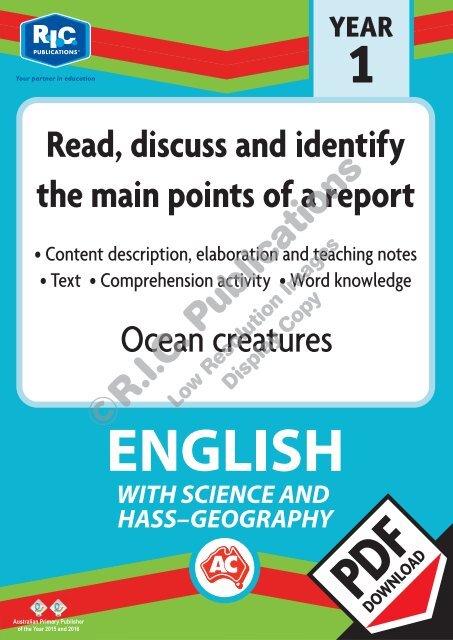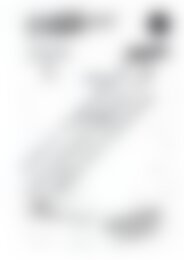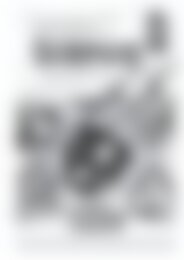RIC-30014 Ocean creatures - Read discuss and identify the main points of a report
Create successful ePaper yourself
Turn your PDF publications into a flip-book with our unique Google optimized e-Paper software.
©R.I.C. Publications<br />
Low Resolution Images<br />
Display Copy
<strong>Ocean</strong> <strong>creatures</strong><br />
• • • • • • • • • • • • • • •<br />
Teacher information<br />
Curriculum links<br />
J<br />
Activity Content description Elaboration<br />
Text • <strong>Read</strong> decodable <strong>and</strong> predictable texts using developing phrasing, fluency, contextual, • Extracts information from a <strong>report</strong><br />
semantic, grammatical <strong>and</strong> phonic knowledge <strong>and</strong> emerging text processing strategies, for • Underst<strong>and</strong>s <strong>and</strong> <strong>discuss</strong>es <strong>the</strong> meaning <strong>of</strong><br />
example prediction, monitoring meaning <strong>and</strong> re-reading (ACELY1659J C,<br />
words<br />
• Respond to texts drawn from a range <strong>of</strong> cultures <strong>and</strong> experiences (ACELY1655) C,<br />
• Engage in conversations <strong>and</strong> <strong>discuss</strong>ions, using active listening behaviours, showing<br />
interest, <strong>and</strong> contributing ideas, information <strong>and</strong> questions (ACELY1656) C,<br />
Comprehension • Use comprehension strategies to build literal <strong>and</strong> inferred meaning about key events, • Monitors reading to see if it makes sense<br />
ideas <strong>and</strong> information in texts that <strong>the</strong>y listen to, view <strong>and</strong> read by drawing on growing • Identifies <strong>the</strong> <strong>main</strong> <strong>points</strong> <strong>of</strong> information from<br />
knowledge <strong>of</strong> context, text structures <strong>and</strong> language features (ACELY1660) C,<br />
a <strong>report</strong><br />
\..<br />
Word knowledge<br />
Additional teacher<br />
information<br />
• Use short vowels, common long vowels, consonant digraphs <strong>and</strong> consonant blends when<br />
writing, <strong>and</strong> blend <strong>the</strong>se to read single syllable words (ACELA1458) C,<br />
• Recognise <strong>and</strong> know how to use simple grammatical morphemes to create word families<br />
(ACELA1455) 0<br />
• Underst<strong>and</strong> that a letter can represent more than one sound <strong>and</strong> that a syllable must<br />
contain a vowel sound (ACELA14591 C,<br />
Definition <strong>of</strong> terms<br />
Text<br />
A book or o<strong>the</strong>r written or printed work, regarded in terms <strong>of</strong> its<br />
content ra<strong>the</strong>r than its physical form.<br />
Story<br />
An account <strong>of</strong> imaginary or real people <strong>and</strong> events told for<br />
entertainment.<br />
Report<br />
A written document describing <strong>the</strong> findings <strong>of</strong> an individual<br />
or group. A <strong>report</strong> may take <strong>the</strong> form <strong>of</strong> a newspaper <strong>report</strong>,<br />
sports or police <strong>report</strong>, or a <strong>report</strong> about an animal, person or<br />
object.<br />
Links to o<strong>the</strong>r curriculum areas<br />
• Science<br />
- Living things have a variety <strong>of</strong> external features (Acssuo111<br />
- Living things live in different places where <strong>the</strong>ir needs<br />
are met (Acssu2111C3<br />
• Humanities <strong>and</strong> Social Sciences - Geography<br />
- The natural, managed <strong>and</strong> constructed features <strong>of</strong><br />
places, <strong>the</strong>ir location, how <strong>the</strong>y change <strong>and</strong> how <strong>the</strong>y<br />
can be cared for (ACHASSK031J0<br />
• Identifies <strong>and</strong> reads words with a variety <strong>of</strong><br />
consonant blends<br />
• Adds <strong>the</strong> prefix 'un-' to words to create new<br />
ones<br />
• Identifies syllables in words<br />
Terminology for students<br />
<strong>report</strong><br />
text<br />
information<br />
story<br />
word<br />
prefix<br />
consonant<br />
syllable<br />
Suggested reading<br />
• National Geographic Little kids first big book <strong>of</strong> <strong>the</strong> ocean<br />
(First Big Books) by Ca<strong>the</strong>rine D Hughes<br />
• Eye wonder: <strong>Ocean</strong> by Prentice Hall<br />
• Over in <strong>the</strong> ocean: In a coral reef by Marianne Berkes<br />
• Commotion in <strong>the</strong> ocean by Giles Andreae<br />
©R.I.C. Publications<br />
Low Resolution Images<br />
Display Copy<br />
1 • · • • • • • • Developing comprehension skills <strong>and</strong> word knowledge (Year 1) • • • • • • R.I.C. Publications ® · • • • • www.ricpublications.com.au
Teaching notes<br />
J<br />
Text<br />
Comprehension<br />
Teacher information<br />
Teacher information<br />
• There are a lot <strong>of</strong> sea <strong>creatures</strong> named in this <strong>report</strong>. Having<br />
access to an internet search engine or children's encyclopedias<br />
for fur<strong>the</strong>r information would be useful.<br />
Introduction<br />
• Lead <strong>discuss</strong>ion about <strong>the</strong> oceans <strong>and</strong> seas <strong>and</strong> elicit from <strong>the</strong><br />
students any sea <strong>creatures</strong> <strong>the</strong>y know <strong>of</strong>. Discuss <strong>the</strong>se. Typical<br />
animals mentioned may be <strong>the</strong> whale or <strong>the</strong> dolphin. Have<br />
pictures <strong>of</strong> <strong>the</strong> catfish, walrus, green turtle, sea otter <strong>and</strong> blue<br />
whale. Tell students that <strong>the</strong>y will read a <strong>report</strong> <strong>and</strong> discover a<br />
lot <strong>of</strong> new information about <strong>the</strong>se sea <strong>creatures</strong>.<br />
Development<br />
• <strong>Read</strong> <strong>and</strong> <strong>discuss</strong> <strong>the</strong> text with <strong>the</strong> students. Assist <strong>the</strong>m<br />
with any unfamiliar words such as 'bony', 'mussels', 'algae',<br />
'mammals', 'abalone', 'urchins', 'shellfish' <strong>and</strong> 'krill'. Question<br />
<strong>the</strong>m to gauge <strong>the</strong>ir underst<strong>and</strong>ing <strong>of</strong> what <strong>the</strong>y have listened<br />
to or read. While reading, observe how students use phonic<br />
skills <strong>and</strong> knowledge to decode words. Assist <strong>the</strong>m to decode<br />
more difficult words.<br />
• Discuss <strong>the</strong> similarities <strong>and</strong> differences among <strong>the</strong> five<br />
animals <strong>and</strong> decide whe<strong>the</strong>r <strong>the</strong>y are carnivores, herbivores or<br />
omnivores.<br />
• If reading <strong>the</strong> text toge<strong>the</strong>r as a class, correct inaccurate<br />
reading.<br />
• A class world map, if available, can be referred to when <strong>the</strong> five<br />
oceans are mentioned.<br />
Differentiated individual/paired/group work<br />
• Assign each group a sea creature from <strong>the</strong> <strong>report</strong> <strong>and</strong> ask <strong>the</strong>m<br />
to find out extra information about <strong>the</strong> creature. Have <strong>the</strong>m<br />
draw a picture <strong>of</strong> <strong>the</strong> animal <strong>and</strong> list some <strong>of</strong> <strong>the</strong> information<br />
<strong>the</strong>y have found. Children's fact books, encyclopaedias <strong>and</strong> <strong>the</strong><br />
internet would be useful resources here.<br />
• Individual students could be asked to place <strong>the</strong> following words<br />
in <strong>the</strong>ir own sentences: whiskers, fins, flippers, mammals.<br />
• In pairs, students can <strong>discuss</strong> o<strong>the</strong>r mammals <strong>the</strong>y are familiar<br />
with. They may have completed pages 54-59 'Hedgehogs'<br />
already. They can try to compare <strong>creatures</strong> <strong>of</strong> <strong>the</strong> oceans with<br />
l<strong>and</strong> mammals. This could provide a link to a science lesson.<br />
Review<br />
• Each group can <strong>discuss</strong> <strong>and</strong> present to <strong>the</strong> class <strong>the</strong> extra<br />
information <strong>the</strong>y have learned.<br />
• Question 1 requires students to use <strong>the</strong> text to find <strong>the</strong> location<br />
<strong>of</strong> <strong>the</strong> various sea <strong>creatures</strong>. Even though <strong>the</strong> text provides<br />
<strong>the</strong> information, it might be worthwhile to look at <strong>the</strong> different<br />
ocean areas on a map or globe.<br />
Introduction<br />
• Revise <strong>the</strong> <strong>main</strong> <strong>points</strong> <strong>of</strong> <strong>the</strong> lesson, talking about each sea<br />
creature in turn (catfish, walrus, green turtle, sea otter <strong>and</strong><br />
blue whale). Establish what <strong>the</strong> students can recall <strong>and</strong> explain<br />
about each creature.<br />
Development<br />
• Discuss <strong>the</strong> comprehension activities on page 86, <strong>the</strong>n allow<br />
<strong>the</strong> students to complete <strong>the</strong> page independently.<br />
• Compare <strong>the</strong> students' answers to Questions 6, 7 <strong>and</strong> 8 as<br />
<strong>the</strong>se will vary.<br />
Differentiated individual/paired/group work<br />
• Students could be asked to summarise <strong>the</strong> information about<br />
each sea creature.<br />
• Less capable students could be asked to write one full sentence<br />
about one creature; more capable readers could write one<br />
sentences about each creature.<br />
Review<br />
• As a class, compare students' summaries <strong>and</strong> see if <strong>the</strong>y have<br />
included all <strong>the</strong> <strong>main</strong> <strong>points</strong>.<br />
©R.I.C. Publications<br />
Low Resolution Images<br />
Display Copy<br />
R.I.C. Publications ® • • • • • • • www.ricpublications.com.au • • • • • • • Developing comprehension skills <strong>and</strong> word knowledge (Year 1) • • • • • • 2
Teaching notes<br />
(continued)<br />
Answers<br />
J<br />
Teacher information<br />
Word knowledge<br />
• The activities on page 87 focus on <strong>the</strong> prefix 'un-', consonant<br />
blends <strong>and</strong> syllables.<br />
Introduction<br />
• Re-read <strong>the</strong> text with <strong>the</strong> students, explaining that <strong>the</strong> focus will<br />
be on words. While reading <strong>the</strong> text, ask students to underline<br />
any words starting with 'er' (<strong>creatures</strong>, crabs).<br />
Development<br />
• Teach students <strong>the</strong> word 'prefix'. Explain to <strong>the</strong>m that prefixes<br />
are added to <strong>the</strong> start <strong>of</strong> a word <strong>and</strong> can change <strong>the</strong> meaning.<br />
Explain that one <strong>of</strong> <strong>the</strong> most common prefixes is 'un-' <strong>and</strong> that<br />
it can make <strong>the</strong> word meaning opposite. Illustrate with several<br />
oral examples first <strong>and</strong> use words that <strong>the</strong> students are familiar<br />
with. Then write <strong>the</strong> words on <strong>the</strong> board without <strong>the</strong> prefix.<br />
Show <strong>the</strong> students that adding 'un-' creates <strong>the</strong> opposite. For<br />
example, happy - unhappy, fair - unfair. Ask <strong>the</strong> students to<br />
look at paragraph 1 <strong>and</strong> to locate <strong>the</strong> word that has <strong>the</strong> prefix<br />
'un-' (unlike).<br />
• Have students complete Questions 1 to 4 independently. Mark<br />
<strong>the</strong>se.<br />
• Before allowing students to complete Question 5, ensure that<br />
<strong>the</strong>y can sound out each blend. Can <strong>the</strong>y think <strong>of</strong> any words<br />
that begin with <strong>the</strong>se blends? Have <strong>the</strong>m complete Question 5<br />
independently <strong>and</strong> mark it.<br />
• Question 6 focuses on syllables. Revise <strong>the</strong> work covered<br />
on syllables from previous units. Have students complete<br />
Question 6 independently.<br />
Differentiated individual/paired/group work<br />
• Ask students to place <strong>the</strong> words in Question 3 into sentences.<br />
Challenge very capable students to use both <strong>the</strong> base word <strong>and</strong><br />
<strong>the</strong> prefixed word in <strong>the</strong> same sentence; (e.g. I was lucky in <strong>the</strong><br />
raffle, but my bro<strong>the</strong>r was unlucky <strong>and</strong> didn't win a prize).<br />
• Very capable readers could try to add five or more words for<br />
Question 5 on <strong>the</strong> back <strong>of</strong> <strong>the</strong> worksheet. These words can be<br />
any words <strong>the</strong> students know or have encountered in <strong>the</strong> past.<br />
Less capable students can add one additional word to each box<br />
(teacher assistance may be needed with spelling).<br />
Review<br />
• As a class, ask students to take turns to call out some <strong>of</strong> <strong>the</strong><br />
words <strong>the</strong>y have added to each box. The teacher can act as<br />
a scribe <strong>and</strong> create a list on <strong>the</strong> board or on charts for each<br />
consonant blend.<br />
Comprehension<br />
1. Teacher check<br />
2. catfish, walrus, sea otter<br />
3. sea otter<br />
4. gives information<br />
5. (a) gills (b) baleen<br />
6. They will die out.<br />
7. No-Catfish <strong>and</strong> sea otters eat snails, so <strong>the</strong>y must live in<br />
<strong>the</strong> ocean, too.<br />
8. Answers may include; cow, buffalo, camel, elephant, elk,<br />
hippopotamus, reindeer, rhinoceros<br />
Word knowledge<br />
1. un-<br />
2. not like<br />
3. (a) unkind (b) unlucky (c) unsafe<br />
(d) unfair (e) unfriendly (f) unlike<br />
4. (a) unlucky (b) unfair (c) unsafe<br />
5. sc-scales, gr-grasses/green, er-crabs/<strong>creatures</strong>, cl-clams,<br />
kr-krill, sn-snails, fl-flippers, sm-small, sw-swim<br />
6. (a) AVlan/tic (b) In/di/an<br />
©R.I.C. Publications<br />
Low Resolution Images<br />
Display Copy<br />
3 • · • • • • • • Developing comprehension skills <strong>and</strong> word knowledge (Year 1) • • • • • • R.I.C. Publications ® · • • • • www.ricpublications.com.au
<strong>Ocean</strong> <strong>creatures</strong> - 1<br />
<strong>Read</strong> <strong>the</strong> <strong>report</strong>.<br />
Many interesting animals live in <strong>the</strong> seas <strong>and</strong> oceans <strong>of</strong> <strong>the</strong> world.<br />
Catfish live in parts <strong>of</strong> <strong>the</strong> Atlantic <strong>Ocean</strong>. They<br />
have whiskers. They have a bony head for digging<br />
up small crabs, snails <strong>and</strong> worms from <strong>the</strong> bottom<br />
<strong>of</strong> <strong>the</strong> ocean. They have fins to help <strong>the</strong>m swim <strong>and</strong> gills to brea<strong>the</strong>,<br />
like o<strong>the</strong>r fish. Unlike o<strong>the</strong>r fish, <strong>the</strong>y have no scales.<br />
The walrus lives in <strong>the</strong> Arctic <strong>Ocean</strong>. It is a<br />
mammal. It has flippers, a large head, small<br />
eyes, tusks <strong>and</strong> whiskers. A walrus uses its<br />
whiskers to find clams, mussels <strong>and</strong> o<strong>the</strong>r<br />
animals on <strong>the</strong> bottom <strong>of</strong> <strong>the</strong> ocean to eat.<br />
It eats coral too. They can be found in many<br />
oceans.<br />
Green turtles live in <strong>the</strong> Indian <strong>Ocean</strong>. They have a _,,.. #/?"Gs: 0 :;:;<br />
hard shell for protection. They have flippers, a tail<br />
<strong>and</strong> lay eggs. They eat crabs, jellyfish, baby sea<br />
animals, sea grasses <strong>and</strong> algae. Green turtles are<br />
in danger <strong>of</strong> dying out.<br />
Sea otters live in <strong>the</strong> Pacific <strong>Ocean</strong>. They are<br />
mammals. They have lots <strong>of</strong> fur <strong>and</strong> whiskers.<br />
They eat urchins, abalone, mussels, clams, crabs<br />
<strong>and</strong> snails. They are good divers. They use small<br />
rocks to crack open shellfish.<br />
©R.I.C. Publications<br />
Low Resolution Images<br />
Display Copy<br />
Blue whales live in many oceans including <strong>the</strong> Sou<strong>the</strong>rn <strong>Ocean</strong>.<br />
These mammals are <strong>the</strong> largest <strong>and</strong> loudest animals in <strong>the</strong> world.<br />
They eat tiny sea animals called krill.<br />
They catch <strong>the</strong>m in hair-like 'teeth'<br />
called 'baleen'. They have babies called<br />
calves. They can live for over a hundred years!<br />
What interesting sea <strong>creatures</strong> do you know?<br />
My learning log When I read this <strong>report</strong>, I could read: 0 all <strong>of</strong> it. 0 most <strong>of</strong> it. 0 parts <strong>of</strong> it.<br />
R.I.C. Publications ® • • • • • • • www.ricpublications.com.au • • • • • • • Developing comprehension skills <strong>and</strong> word knowledge (Year 1) • • • • • • 4
<strong>Ocean</strong> <strong>creatures</strong> - 2<br />
Comprehension<br />
1. Draw a line from each animal to an ocean where it can be found.<br />
catfish<br />
walrus<br />
green turtle<br />
•<br />
•<br />
•<br />
sea otter<br />
blue whale<br />
•<br />
•<br />
2. Which three animals in <strong>the</strong> text have whiskers?<br />
3. Which animal uses a tool to get food?<br />
4. Th is text ... gives information 0<br />
5. Which word means:<br />
(a) <strong>the</strong> body part fish use to brea<strong>the</strong>?<br />
(b) hair-like 'teeth' <strong>of</strong> a blue whale?<br />
6. What will happen if we don't look after green turtles?<br />
7. Do snails live only on <strong>the</strong> l<strong>and</strong>, in gardens?<br />
l Yes) 8<br />
How do you know?<br />
tells a story D<br />
©R.I.C. Publications<br />
Low Resolution Images<br />
Display Copy<br />
8. Which l<strong>and</strong> animals have babies called calves?<br />
My learning log<br />
While doing <strong>the</strong>se activities:<br />
I found a __ easy. I I found a __ tricky. I I found a __ fun.<br />
5 • · • • • • • • Developing comprehension skills <strong>and</strong> word knowledge (Year 1) • • • • • • R.I.C. Publications ® · • • • • www.ricpublications.com.au
<strong>Ocean</strong> <strong>creatures</strong> - 3<br />
Word knowledge<br />
1. Write <strong>the</strong> prefix at <strong>the</strong> beginning <strong>of</strong> 'unlike'. ________ _<br />
2. The prefix 'un-' in 'unhappy' makes <strong>the</strong> word mean 'not happy'.<br />
What does <strong>the</strong> word 'unlike' mean?<br />
not _________ _<br />
3. Add 'un-' to <strong>the</strong>se words.<br />
(a) kind<br />
(c) safe<br />
(e) friendly ______ _<br />
4. Colour <strong>the</strong> correct word.<br />
(b)<br />
(d)<br />
(f)<br />
lucky ______ _<br />
fair<br />
like<br />
l nlike<br />
'l nlucky '<br />
(a) He never wins anything. He is very ---====__._I _________ __.J,_<br />
l Jl unfair unlike }<br />
(b) The referee in <strong>the</strong> football match was very<br />
l J (c) The busy road was unkind l J_ unsafe<br />
5. Write one word from <strong>the</strong> text beginning with each pair <strong>of</strong> consonants.<br />
SC gr er<br />
cl kr sn<br />
©R.I.C. Publications<br />
Low Resolution Images<br />
Display Copy<br />
fl sm SW<br />
'-<br />
6. Write each word correctly in <strong>the</strong> syllable box.<br />
l I J<br />
(a) Atlantic<br />
l<br />
(b) Indian<br />
I J<br />
My learning log<br />
Colour:<br />
I know how to use <strong>the</strong> prefix 'un-'.<br />
I can think <strong>of</strong> words that start with 'gr' <strong>and</strong> 'sc'.<br />
R.I.C. Publications ® • • • • • • • www.ricpublications.com.au • • • • • • • Developing comprehension skills <strong>and</strong> word knowledge (Year 1) • • • • • • 6


